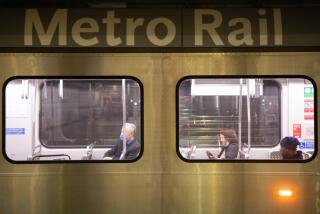Metrolink struggles with reforms
- Share via
As the anniversary of the Sept. 12 Chatsworth train disaster approaches, officials with Southern California’s sprawling commuter rail service are facing a vexing array of technical, financial and potential legal challenges as they struggle to deliver on pledges of trailblazing safety reforms.
A burst of energy to remake the region’s Metrolink train operation was unleashed by the deadliest rail collision in modern California history, a watershed event that killed 25, injured 130 and prompted landmark federal mandates to modernize the nation’s rail safety systems.
Today, the rush to reform Metrolink -- a thinly staffed hybrid transportation agency once derided as the political stepchild of the five counties that created it -- is becoming increasingly costly, time-consuming and complicated.
Labor leaders are digging in to fight an unprecedented push by agency officials to place locomotive train crews under continuous video surveillance.
Technical and financial challenges loom over an ambitious schedule to a deploy a $200-million collision-avoidance network for all commuter, freight and intercity trains moving across hundreds of miles of track.
Meanwhile, Metrolink officials have reversed course on an effort to assume direct control over hiring, training and supervising rail crews, a move prompted partly by disclosures that in Chatsworth, an engineer employed by a contractor apparently ran a red light while sending a text message on his cellphone just before colliding head-on with a freight train.
Fearing that trying to manage on-board train crews could overtax staff and trigger thorny labor issues, Metrolink’s board of directors opted to farm out the critical function again, this time to Amtrak.
Compounding financial strains, ridership has been sliding since the crash, largely because of lower gas prices and the recession. Fare revenues dropped $1.4 million below estimates in the last quarter alone.
And operating insurance premiums recently surged $1 million above estimates because of Metrolink’s accident history over the last decade, averaging one potentially catastrophic liability payout every two years, records show.
Although no major wrecks have occurred since Chatsworth, smaller accidents involving cars and pedestrians are running about the same this year as last -- 3.25 and 3.4 per month, respectively, the agency says.
But a rash of incidents leading up to this week’s memorial observances has served as a reminder of the risks Metrolink confronts in its heavily urban mixed-rail environment.
In one potentially horrific crash last month, rescuers in Oxnard were aiding an auto accident victim at a crossing on track owned by Union Pacific. Police and firefighters tried to alert the freight railroad. But word failed to reach a Metrolink train in time and it slammed into the injured man’s disabled pickup seconds after rescuers pulled him free.
Some Metrolink officials stressed that the agency was not at fault. But several board members say the incident shows that communication and safety oversight problems persist.
“There is a complete breakdown. . . . There is no excuse for this,” said board member and Los Angeles County Supervisor Mike Antonovich. “We almost lost two police officers and a fireman and this victim.”The dimensions of the issues confronting Metrolink are indeed daunting for an agency staff that has remained small because of outsourcing as ridership has grown.
Just fielding the new so-called positive train control system -- years ahead of the rest of the country -- will be “a big lift” for Metrolink, said Kitty Higgins, a former National Transportation Safety Board member who oversaw investigative hearings this year on the Chatsworth crash.
Such a system, which can use satellite positioning, on-board automatic braking computers and trackside telemetry, is supposed to cover more than 500 miles of Metrolink routes at a cost of $201.6 million to the agency alone.
“I think [Metrolink has] the right goals,” Higgins said, adding that the agency’s aggressive safety agenda appears to have helped reassure the public. “The question is what’s the realistic target for getting from here to there.”
Agency leaders insist they are on course to position Metrolink at the forefront of rail safety in the country.
They cite a number of changes already being made. Among them: placing a second crew member as a lookout in control cabs, fast-tracking less sophisticated automatic train stopping equipment for dozens of potentially hazardous track junctions, strengthening safety rules and increasing the number of personnel hunting for violations.
And despite months of slippage on its delivery schedule, Metrolink is first in line for a new generation of passenger cars that are supposed to reduce damage in a collision and better protect riders.
“I’m very pleased with the significant amount of progress the agency has made on a number of fronts,” said Metrolink Chairman Keith Millhouse. “Yes, there are some lead times on these [reforms]. But the journey begins with a first step.”
One of the more sobering lessons of the Chatsworth disaster is that it might have been avoided in any number of ways: by adhering to safety regulations, demanding more aggressive and diligent enforcement of rules or investing in new technologies.
Metrolink engineer Robert M. Sanchez, working under a contract with Connex Railroad, had a history of text-messaging while on duty, records show. He also had been personally warned about cellphone use on locomotives.
Still, he sent and received hundreds of text messages in the days before the crash, investigators found. His last message before he was killed went out about the time the train sailed through a red light and into an oncoming Union Pacific freight train, according to preliminary NTSB findings. A final report is expected around the end of this year.
Metrolink leaders say layers of new and improved safety redundancies will help avoid a repeat of any such scenario.
For example, the agency is pressing ahead with installation of inward-facing video cameras trained on locomotive engineers. Metrolink Vice Chairman Richard Katz insisted that “there is no immediate safety improvement as important as inward-facing cameras.”
But just how hundreds and hundreds of hours of weekly video will be reviewed and handled hasn’t been resolved.
And the Brotherhood of Locomotive Engineers & Trainmen, which represents Metrolink/Connex engineers, says the system is an invasion of privacy, ineffective as a safety tool and open to abuse by supervisors. Taking a cue from commercial airline pilots, the union has signaled that it may sue to head off the program, the first of its kind on the nation’s railroads.
Cameras are a critical safety measure until positive train control is up and running, officials say.
That is supposed to happen in Southern California in 2012, three years earlier than the federal deadline for the nation as a whole.
Some experts are questioning whether the 2015 national timeline is realistic. Nonetheless, Metrolink, Union Pacific and other key parties say they remain committed to getting Southern California’s system in place early.
Thus far only $75 million has been secured, though officials are optimistic more federal money will arrive.
Demonstration projects have shown the complex systems do prevent train-on-train collisions. But they are not necessarily foolproof.
“The good news about getting it first is we’re getting it first. The bad news about getting it first is, we’re also getting it first,” Katz said. “Hopefully they’ll work out all the kinks. But to a large extent, we’re the guinea pigs, in that sense.”
Union Pacific spokesman Tom Lange stressed that for positive train control to succeed, numerous sophisticated systems must “operate seamlessly and with virtually fail-safe standards under all conditions.”
But making it work -- and work quickly -- is essential, Metrolink officials say.
“We need it badly, and we need to hold the railroads’ feet to the fire so they start it out here as early as possible,” Katz said. “Possibly in 2012.”
--
More to Read
Sign up for Essential California
The most important California stories and recommendations in your inbox every morning.
You may occasionally receive promotional content from the Los Angeles Times.













